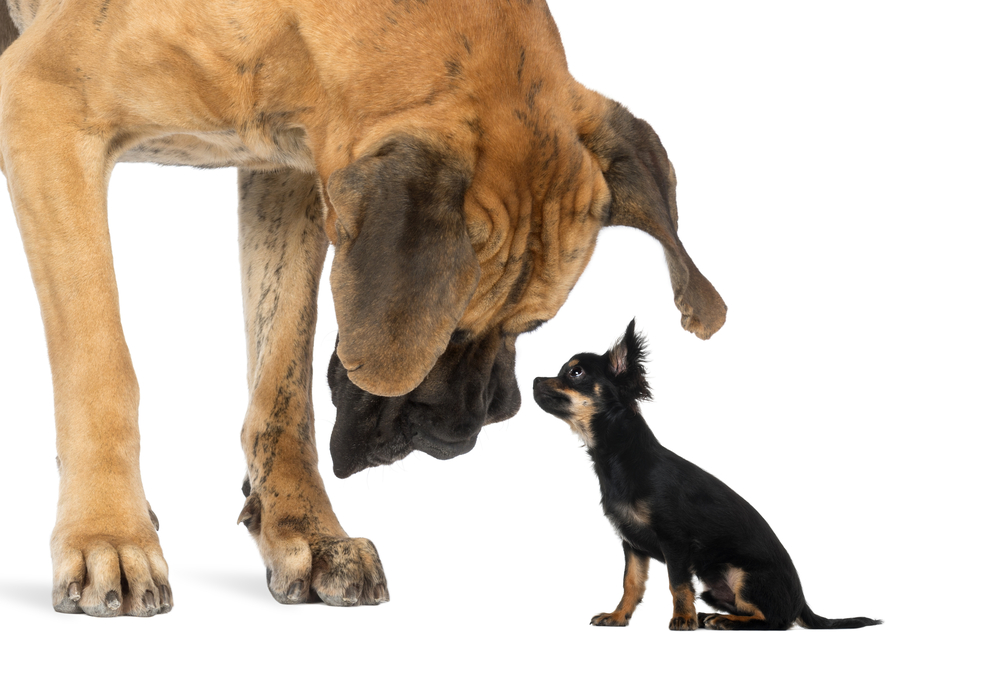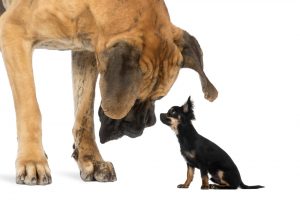If you’re looking forward to the days when your puppy will stop outgrowing their dog beds and finally be able to accompany you on your jogs, the question on your mind is, “When are dogs full-grown?”
There are many factors that determine how long it takes for dogs to be fully grown, which is why the standard (and very broad) estimation of eight months to three years is probably not as helpful as you were hoping for. In this article, we’ll break it down so that you can have a better sense of how long it will take your unique dog to go from wrinkly puppy to distinguished doggy adult.
First of all, when are dogs full-grown? What does fully grown mean?
There are many milestones that your little furball will reach during their first few years of life. By the time you celebrate their first birthday, for instance, they’ll have reached sexual maturity and (hopefully!) mastered potty training. And, some will pass through the dreaded teenager phase by the time they’re about a year and half or two years old.
But, what we’re referring to here is your dog’s physical growth. Just how long does it take to reach their full size? And why does it matter?
Well, as you might already have already surmised by how quickly your pup grew out of their first collar, knowing when your dog will reach their full size and weight will help you buy the right equipment for them, such as their crate, harness, and dog bed. As we all know, dog supplies can be quite expensive! And you might not want to splurge on something that your dog will grow out of in a couple of months.
Secondly, physical growth is a huge factor in how much exercise a dog can do safely. When dogs are full-grown, they’ll gladly keep up with all of your outdoor adventures. But for puppies, it’s important to keep things mellow with supervised free play sessions with other dogs and short walks with you or a dedicated Dog Walker. Until your dog’s growth plates have solidified, they should be on a moderated exercise plan that minimises high impact on their joints.
In sum, once you know that your doggo has reached their full size, then you can shop online for all the supplies you want and start making plans for your dog’s future in sports!
How long do dogs grow based on breed size?
One of the best ways to determine how long it will take for your dog to grow into their final size is to look at their breed.
Small dog breeds, for example, typically reach their full size more quickly. Very small dogs like Chihuahuas and Yorkies may be fully grown by about 10 months, while slightly larger breeds like the Cavalier King Charles Spaniel will typically reach their adult size in about 12 months.
Large dog breeds, on the other hand, have a bit more growing to do! In fact, dogs in the large to giant breed category can increase their birth weight by around 100x by the time they’re full grown! Small dogs, in contrast, may only grow somewhere between 15 to 20x their original weight. A German Shepherd-sized dog will typically keep growing until they’re about 18 months old, while super puppers like the Great Dane or Bullmastiff may not stop growing until they’re two or even three years old.
If your dog is an adorable mix of different breeds, it may be a bit more challenging to anticipate what their final size will be (and therefore, how long it will take them to grow). There are some ways to estimate, such as looking at your dog’s paw size or the prominence of their rib knobs, to see whether they have more growing to do. You may also rely on a calculation, such as multiplying your dog’s weight at 6 months by 4 (for small dogs) or 2 (for larger dogs). But, you’ll probably get a more accurate idea of how long it will take your dog to grow by completing a DNA test.
What other factors help answer the question, “When are dogs full-grown?”
While size is a pretty reliable way to predict how long it will take your dog to grow, there are a few other factors to look at:
- Nutrition. Proper nutrition is important for all of your dog’s life stages, but especially when they’re still growing. If your dog is on a healthy, high protein diet, you can be sure that they’ll reach their full size and weight on a normal timeline for their breed
- Desexing. There are some theories that early desexing can affect your dog’s final size, as the changes in hormones might prolong the growth process. The final difference in size seems to be nominal, but some Dog Owners choose to wait until their dog has passed through the majority of their growth phase before desexing. It’s always best to talk with your vet and have them assess your unique dog
- Overall health. Ideally, your puppy will be able to focus all of their energy on learning new tricks, meeting new friends, and of course, growing up big and strong. But, in the case of stress, illness, or internal parasites like hookworm, your dog might be spending their energy trying to overcome whatever is ailing them. Not surprisingly, this can slow your dog’s growth down, which is why it’s important to keep a close eye on your puppy’s health
Again, these are a few things that can affect how quickly your dog grows, but every pupper is different.
Not satisfied with estimation? Your vet might have a better answer to your question, “When is MY dog fully grown?”
Unfortunately, there is no crystal ball that we can turn to for an answer to our question. But, science can help! If you’re anxious to know when your doggo will be able to take on the role of running partner or frisbee dog competitor, ask your vet to monitor your dog’s growth via x-ray.
In the meantime, give them healthy food, schedule leisurely walks with you or their doting Dog Walker, and cuddle up for proper rest and recovery. Before you know it, your tiny little puppy will be a full-grown dog!


